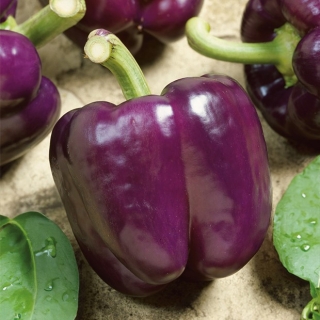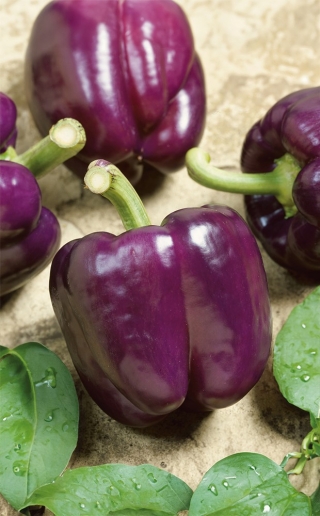The Loran pepper is a medium late variety whose fruit take on an intriguing colour. Thick, rectangular fruit that weigh about 190 grams, should be grown in greenhouses. Presented variety stands out with its appetizing colour when ripe for consumption - it is dark purple, almost black at times. Thanks to that unique colouring and an excellent sweet taste, the Loran pepper complements many dishes. Crunchy pepper chunks taste great in salads, sandwiches, and other cold dishes. This pepper can also be stir-fried, steamed, and roasted. Pepper is a rich source of easily available vitamin C, a natural anti-oxidant that has a life-saving impact on our body. It reduces risk of cancer and slows down ageing processes. Peppers belong low-calorie vegetables. They are rich in natural sugars and juicy. These features make it one of the most popular vegetables worldwide.
The heat-loving pepper needs a place in the sun to thrive, still it prefers situations that are at the same time sheltered from the wind. The ideal soil for growing peppers must be permeable and rich in nutrients. It is worth to enrich the site with a substantial dose of compost before planting. Sow pepper seeds onto trays - those need to be pricked out later - or into small single pots, where you only leave the strongest seedling. Make sure that the soil remains moist while growing seedlings and that they have uninterrupted access to sunlight. Harden seedlings for one to two weeks before transplanting them to the permanent site. Growing your own seedlings should take you from nine to ten weeks if everything goes well. Plant seedlings 50 x 50 centimetres apart. Keep the soil moderately moist during the entire growing period. It is critical particularly at the fruit development stage. Apart from watering, you only need to weed the borders and loosen the soil around the plants. Fruit are harvested gradually as they mature, in several rounds.
One package contains 0.3 grams of seeds. Basic plant facts and growing tips can be found at the back side of the packaging.
- Use: raw in salads and sandwiches; stir-fried, steamed, and roasted
- Site: sunny, sheltered; permeable, fertile, moderately moist soil
- Weight: 0.3 g
GardenSeedsMarket - has been in business for more than a decade and from the very beginning we have made the quality of our products the top priority. Throughout the years we have delivered the best quality goods to tens of thousands of customers from all over the world. Their satisfaction proves that we had chosen the right way.
All seeds we sell are subject to a multi-level quality control checks and only then are carefully packed and dispatched. Our products have been awarded numerous certificates and comply with the highest standards of the European Union. Our employees are experienced gardeners who are more than happy to answer your every question.
Where do our seeds come from?
All of the seeds sold in our shop come from the best producers from across the European Union. Thanks to a long-standing cooperation with them we were able to develop the most adequate storing and dispatch conditions, guaranteeing that you always receive fresh and carefully tested batches of seeds. Exclusion of the middlemen from the whole process not only makes it possible for us to avoid sending out-of-date seeds that might have been lying too long on a warehouse shelf, but also ensures the most attractive price for top quality products.
The quality control process
All our seeds must pass a four-stage quality control process.
Stage one begins with a careful selection of the suppliers. Than we proceed with controlling their crops, foreign producers are not excluded from the quality control process. Plants are checked at every stage of their development: when they start to grow, during blooming and when they start bearing fruit (seeds). At this stage the most important thing is to ensure proper spacing of the plants. Thanks to that obtaining the desired morphological characteristics of each particular species or variety, such as colour, height and shape, can be ensured.
Stage two consists of a detailed verification tests in laboratory conditions. With the use of the highest quality equipment by the highly qualified staff, our suppliers perform more than 30 000 quality checks annually. The seeds that do not meet our requirements are subject to technological refining processes, including drying, cleaning, upgrading and testing again.
Stage three starts with sowing seeds in selected control plots. That way we obtain valuable, exact information concerning their germination that must be maintained at an appropriate level. Simultaneously, the varietal identity of each species is checked at this stage.
Stage four takes place in our warehouses and consists of eliminating seeds that have been stored for too long on our shelves and replacing them with new batches. Each package is stamped with a unique batch number and also with the sow-by-date.
All four stages combined allow us to state with confidence that the seeds we deliver comply with the highest standards and have completed all required control stages with flying colours.
Prizes and awards
The seeds we sell are widely recognized for their quality and have won many awards. Our seeds won numerous gold medals and distinctions for their high quality. The World of Flowers was also honoured for its innovative approach.
Among those awards there were: TOP INNOVATION (June 2015), GOLD MEDAL AT THE POZNAN INTERNATIONAL FAIR (2015), CONSUMER QUALITY LEADER (2014), FARMER OF THE YEAR (2014).
In addition, we have also been awarded the “IDEAL BUSINESS” certificate for two years in a row.
Germination
We are committed to selling only the highest quality seeds. Taking into consideration the efforts we make daily, please also note that plants are living organisms and their germination and growth depends on many factors, such as temperature, soil type, humidity and the frequency with that they are watered, sowing time and conditions, use of fertilizers and plant protection agents (pesticides), as well as weather and climate conditions. We provide help by sharing the accurate and up-to-date sowing and growing information, however, we cannot bear any responsibility for the plants that were not cultivated in conditions appropriate for given species.







